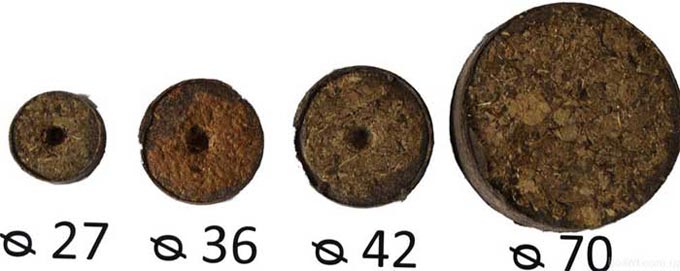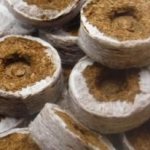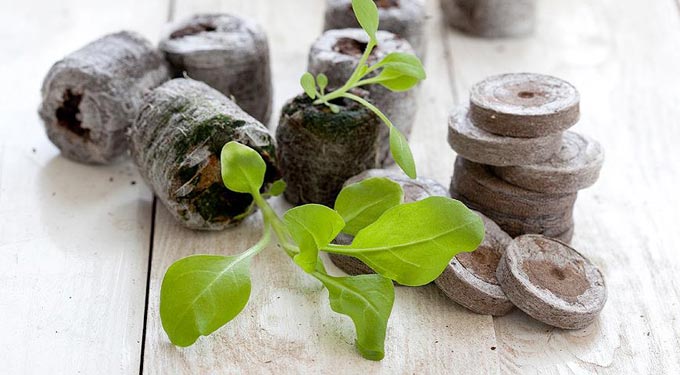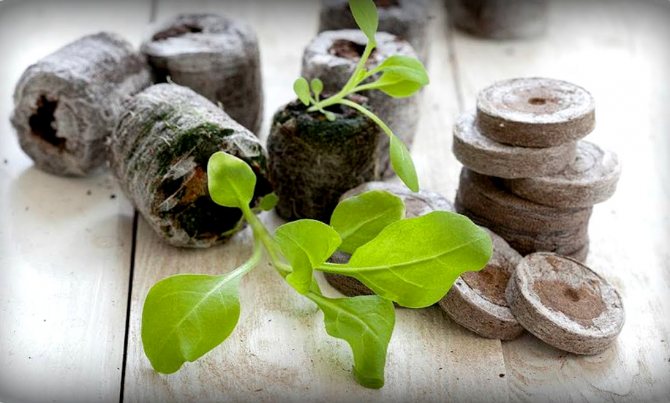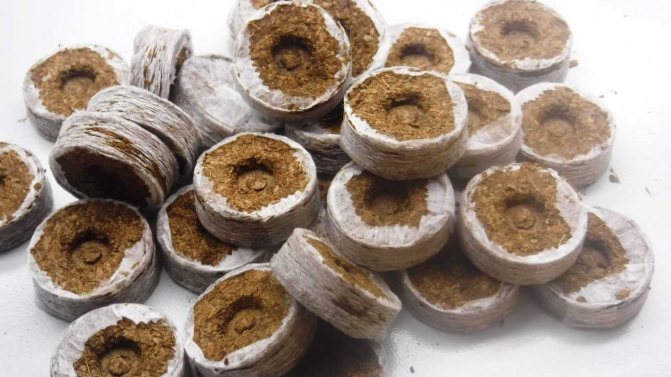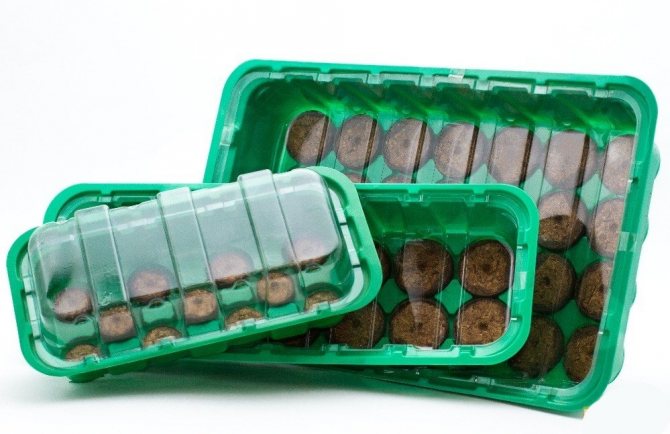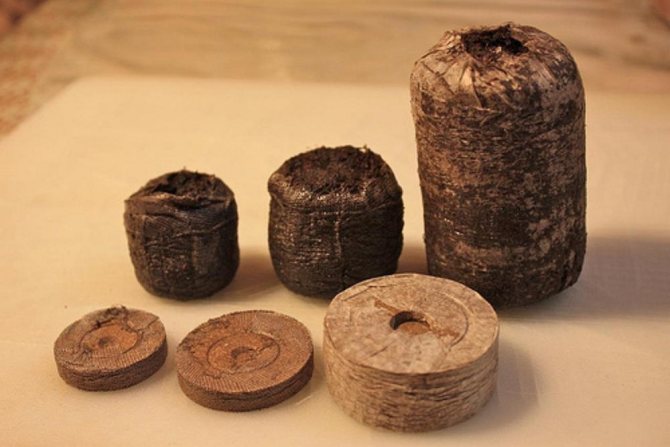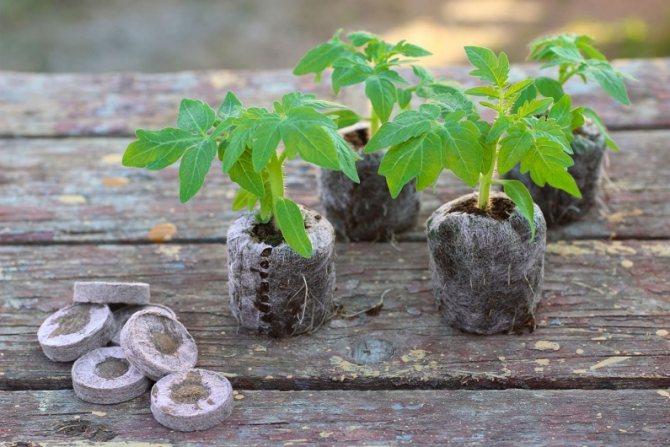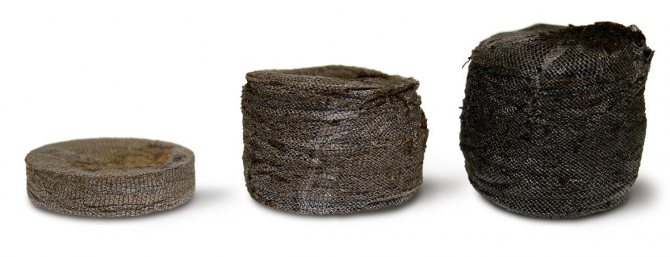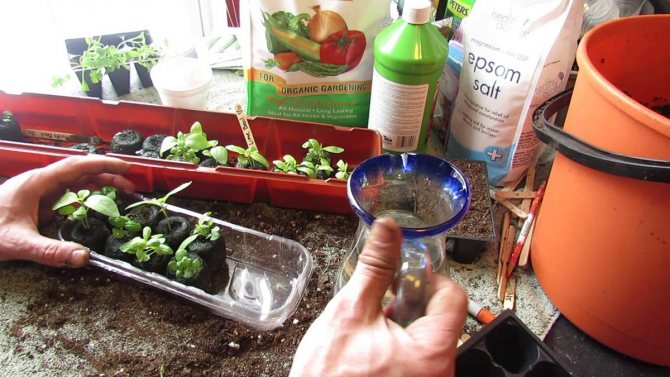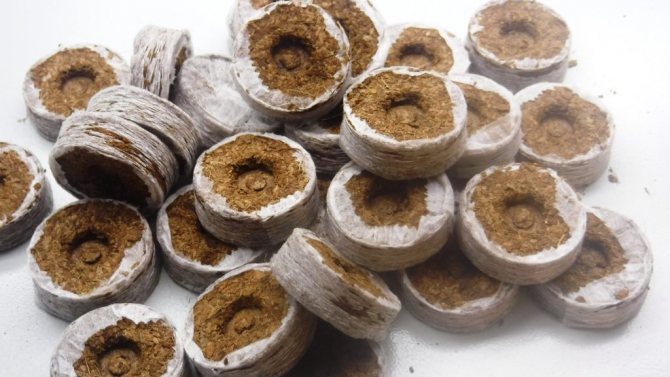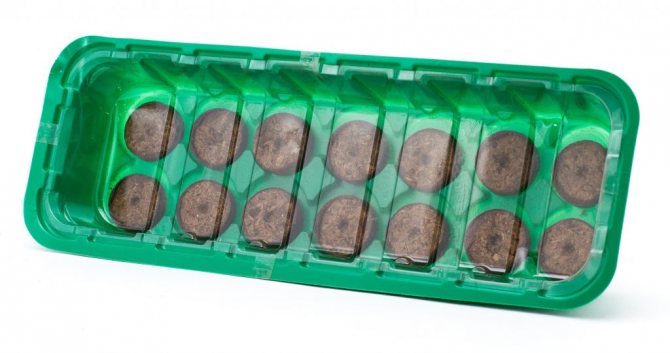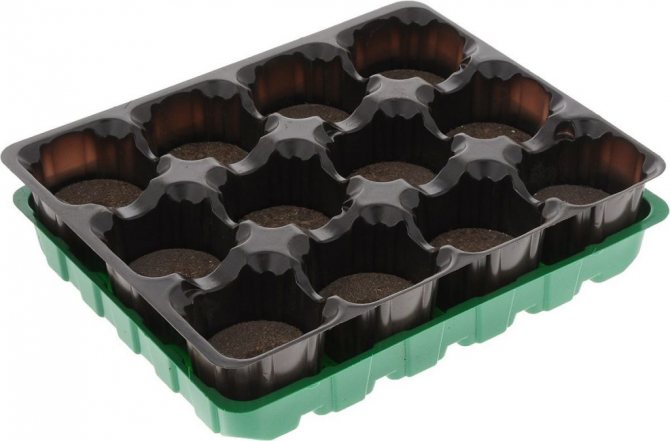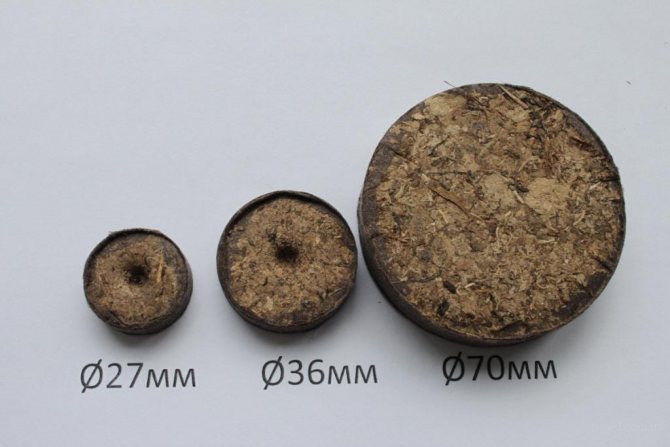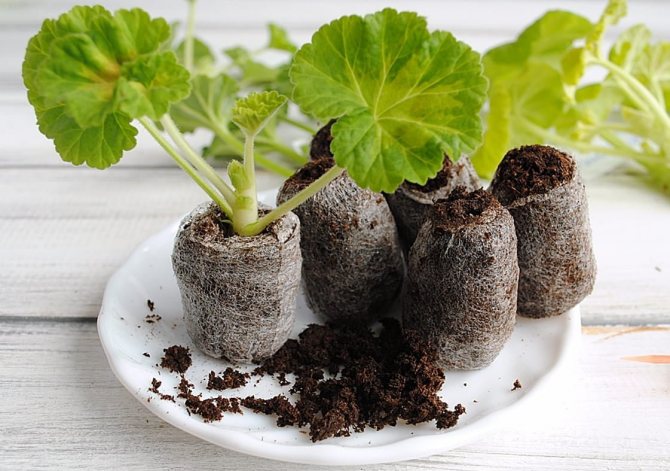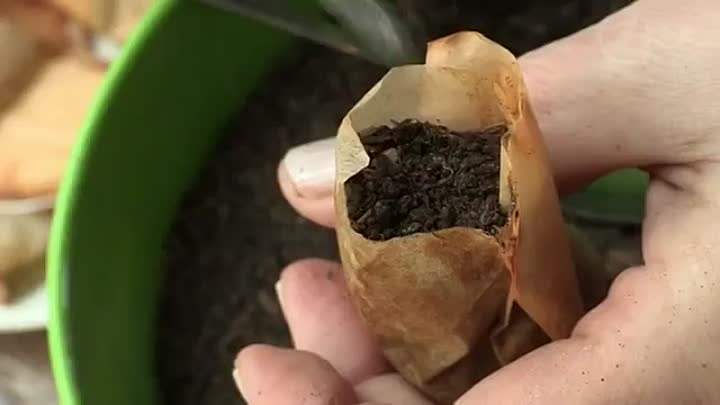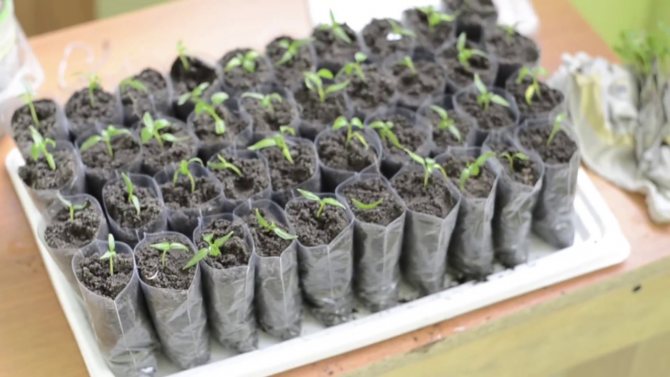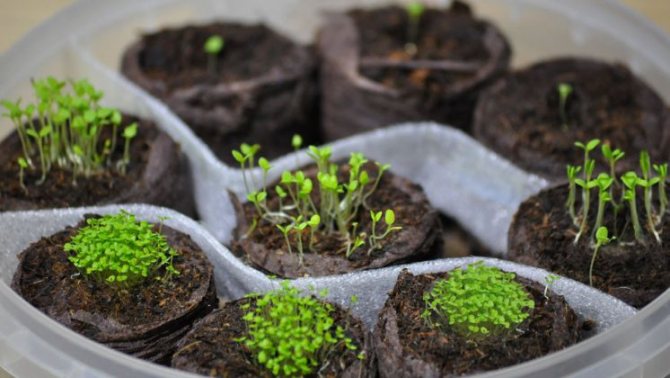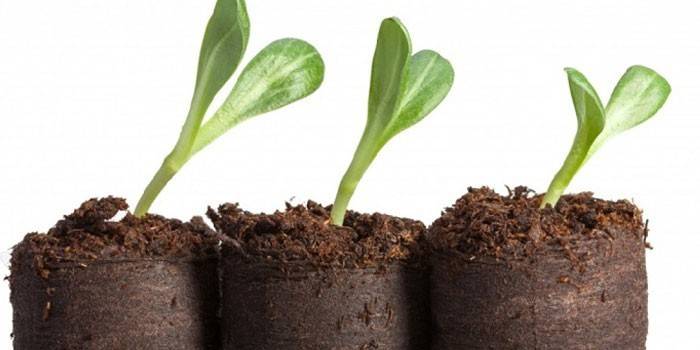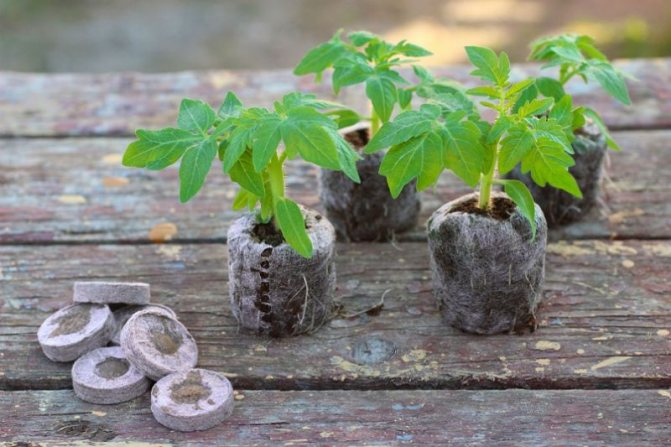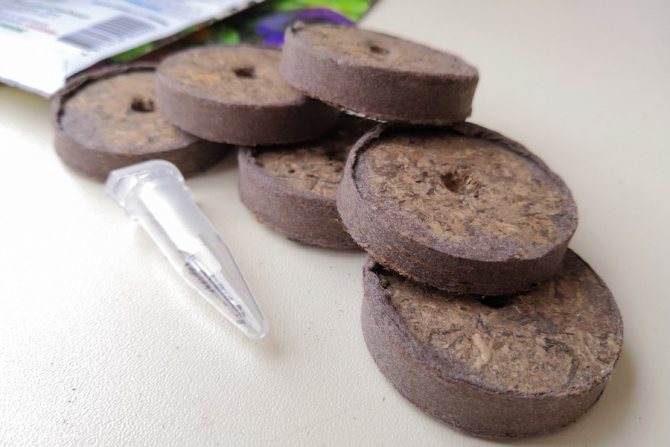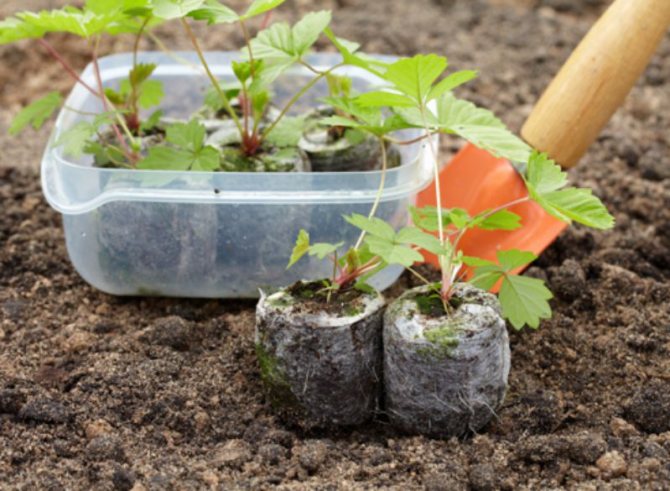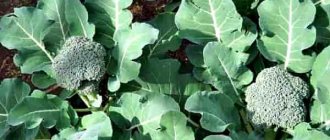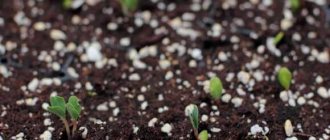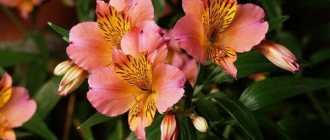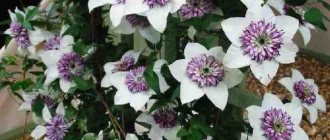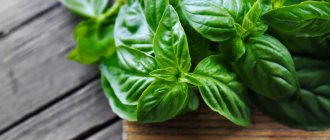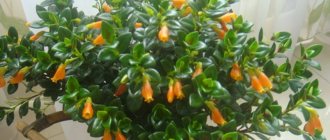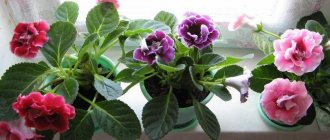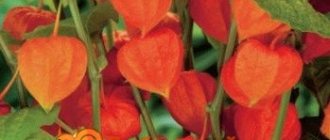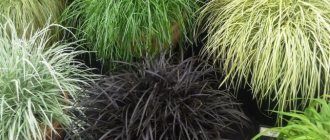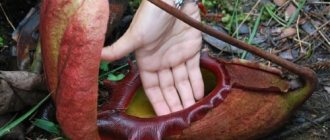There are many ways to help speed up seed germination and get healthy and strong seedlings in a short time. The method of using peat tablets is popular and simple. This is an absolutely safe and environmentally friendly invention that greatly simplifies the cultivation of various crops. It is easy to use and the benefits are great.
What are peat tablets for seedlings
To help gardeners, scientists have developed many useful tools that facilitate the hard work of homeowners. One such development is peat pellets for seedlings.
Their use makes it possible to germinate the seeds of cultivated plants faster, nourishes them with strength, due to which strong viable juveniles are obtained. The tablets are elementary easy to use, but the benefits from their use are incomparably great.
The material for manufacturing is, as a rule, a mixture or a high-moor type of peat, containing enough substances and compounds, so necessary only for the shoots that are gaining vitality. The washers, the sizes of which vary from 2.4 cm to 9 cm in diameter, are covered with a special mesh. The height of the tablet in its original form is no more than 3 cm.
The main characteristics can be considered the natural capabilities of peat - good moisture and air permeability, in addition, plant roots do not encounter obstacles during their development.
The recess or special hole where the seed is placed is located on the side of the disc or on the top of it. When warm water hits the washer, it increases and grows several times. Many novice gardeners are wondering whether it is necessary to remove the mesh when planting seeds? No, since it holds the shape of the resulting glass, not allowing it to go to the sides. This nutrient cup is the first habitat for a future adult.
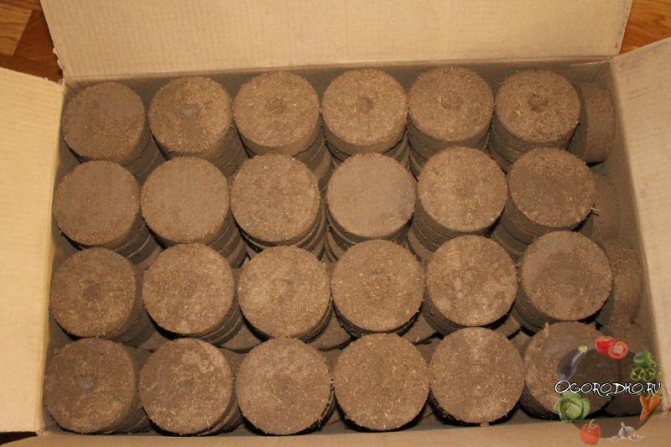
Peat tablets for seedlings - pictured
Those housewives who have already tried this invention instantly appreciated its advantages. First of all, this is the absence of the need to fiddle with the soil, especially if you live in an apartment, as well as significant savings in space. The use of tablets has other advantages:
- Due to its loose structure, peat does not damage the thin and weak root system of the young shoot
- An irreplaceable method for germinating small or expensive seeds that have a low germination rate in the soil
- When germinating seeds in this way, it is easy to control the irrigation process - the tablets do not absorb unnecessary water
- The use of this tool allows you not to use additional food - substances that stimulate plant growth
- The root system, located in such an environment, is provided with good oxygen access, since peat is highly air-permeable.
- Thanks to the protective mesh, the plant can be planted in open ground without damaging the roots
As you can see, there are quite a few advantages of using this method, their benefits are obvious. How to choose peat washers for seedlings and use them - read on.
Description
Peat tablets are made from high-moor peat or a peat mixture containing nutrients necessary for plants in the early stages of development.Above, you can see a special coating - a mesh that prevents the decomposition of moist peat. The width of the products varies from 24 mm to 90 mm, the height does not exceed the 30 mm mark. Thanks to peat tablets, you can germinate any garden and flower crops. Peat tablets are especially good for plants that do not tolerate picking and sprouts with delicate and fragile shoots. The same goes for expensive and rare seeds.
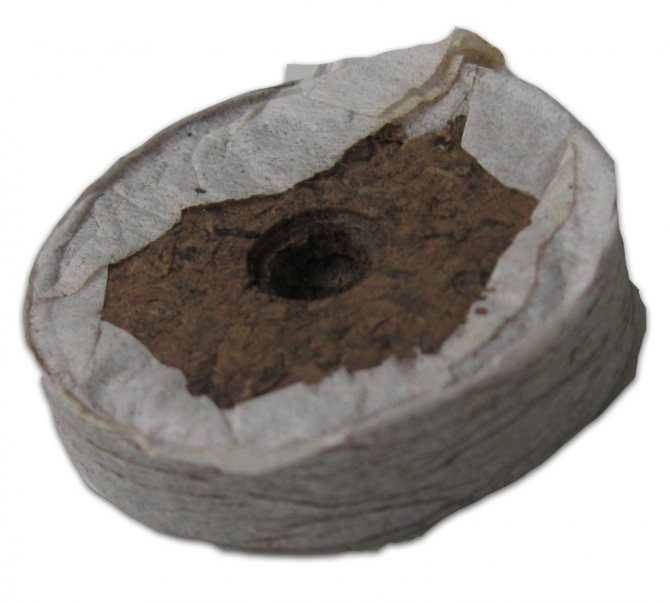

The hole for the seeds in the peat press is clearly visible, as well as the mesh covering the material
The positive aspects of using peat tablets include:
- the speed of seed germination;
- compactness;
- environmental friendliness;
- the ability to grow seedlings without additional fertilization;
- no need for picking and work with the ground.
There are only three main disadvantages of these products. Firstly, this includes the need for frequent watering caused by the rapid drying of peat. Secondly, the need to use pallets. Thirdly, a rather high price, which does not allow avoiding serious costs when planting a large number of plants.
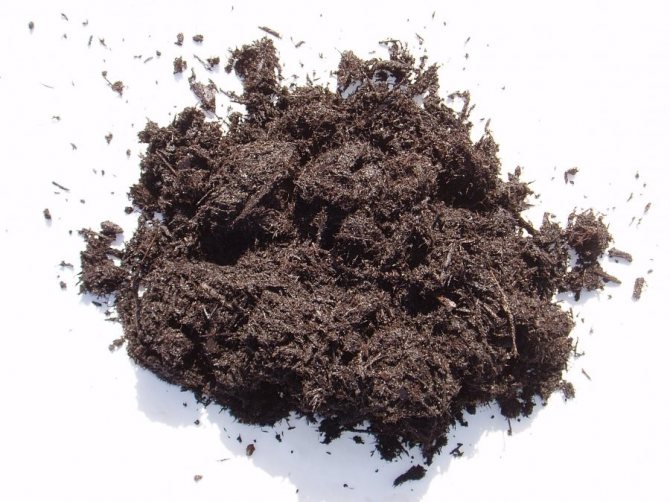

The main component of peat pellets is completely environmentally friendly and clean
How to use peat washers
Before placing the seed, the peat disc must be prepared for use. This is done according to the following scheme:
- We select a pallet of a suitable size and lay out the tablets on it so that the recess is on top
- Pour 2-3 tablespoons of warm water into the recess (you can pour it into the pan) and wait until the peat swells. This will take no more than a quarter of an hour.
- Remove excess liquid from the pallet
- Put a seed of future seedlings in the groove on each tablet
- Sprinkle a little earth or humus on top of the seed. The only exceptions are those seeds that need light to germinate.
- We cover the pallet with plastic wrap or glass (plastic) in order to create the effect of a greenhouse
- Periodically let the landings "breathe"
At the initial stage of seed germination, you do not need to use any additional fertilizing, since all the necessary substances are already included in the peat tablets. The first fertilization should be applied 14 days after the plant has released the first leaves. Add nutrients to the irrigation water.
The young shoots that have been born should be grown as required by the given culture. When the seedlings are ready for planting on the garden bed, it is enough just to transfer it to the hole in the ground right in the tablet, where the roots are firmly fixed. The mesh that covers the tablet will dissolve in the soil, and the same will happen with peat in the future.
How to use peat tablets for planting seeds
Preparation for planting in peat tablets requires a minimum of work. For this purpose, it is necessary to put dry washers in an optimal container, for such moments it is extremely practical to use a rectangular plastic container. The molds should not be folded very tightly, small openings will improve ventilation, and besides that, growing nearby saplings will not interfere with the roots.
Then you need to fill the tablets with soft, settled and warm water. Within about 30 minutes, the spongy material will swell well, and small rounds will grow into some kind of peat cups. The tablet practically does not change its diameter, but it can grow up to 7 times in height. Then the excess water must be removed from the container. The preparatory technological process is over - the nutrient base is ready for receiving the seeds.
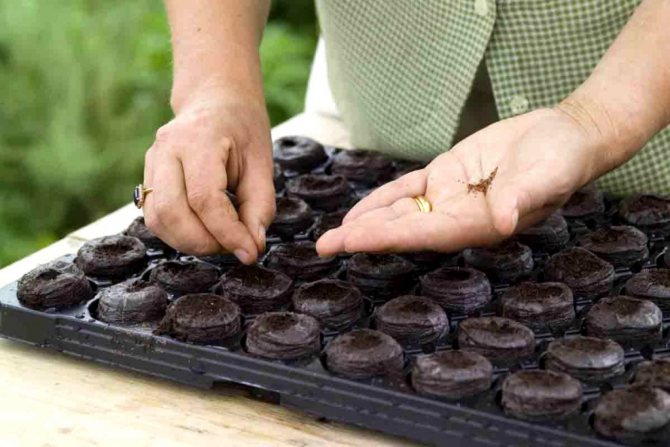

At this stage, another clear advantage is revealed. Common land used for planting is generally not used for germination. The dense structure does not provide enough moisture, warmth and light for good sprouting from seed.To increase the likelihood of success, gardeners need to germinate each grain in advance.
The looseness of the texture of the peat tablet makes it possible to do without the exhausting preparation of the planting material. If the culture being cultivated is not very difficult, then it is enough to take 1 seed and slightly press it into a special depression located in the upper part of the tablet.
If necessary, the seed can be deepened in addition by pressing it a little with a match or a toothpick. The form, softened by water, is freely perforated, without deforming the seed shell at all. The rotated sprout is heated by the heat of the sun, taking in water, fresh air and necessary microelements through loose peat, and stretches out quite rapidly.
Seeds planted in a peat tablet have good germination. This must be used when breeding the rarest and most expensive varieties, in situations where any grain is worth its weight in gold and the loss of a sapling is impermissible.
Watering
Unlike breeding young plants in a pot or a glass of soil, a peat tablet simply cannot be waterlogged. The easiest way to water the seedlings is from the bottom, using a pallet, gradually adding water. The spongy structure of the peat tablet is very quickly soaked, does not capture excess moisture, stores an excellent air flow, does not sour, prevents rot, and promotes healthy root formation.
Seedling care
Seedlings are almost always not formed rhythmically. Differences in the arrangement of seeds, location in the ground, the availability of nutrients and a large number of other external factors lead to the fact that certain seedlings lag significantly behind their green comrades. If the seeds are planted by the classical method, in 1 large container with soil, it will be difficult to help the lagging seedlings. Since in order to simply transfer frail seedlings to an individual place for growing, you will need to make a dive. It makes sense to say that such anxiety is a dangerous risk of damage to the root system and the death of a young plant. Saplings sprouted in separate peat pellets are simply subject to sorting. It will not be difficult for the gardener to distribute the seedlings and separate them from the healthy plants.
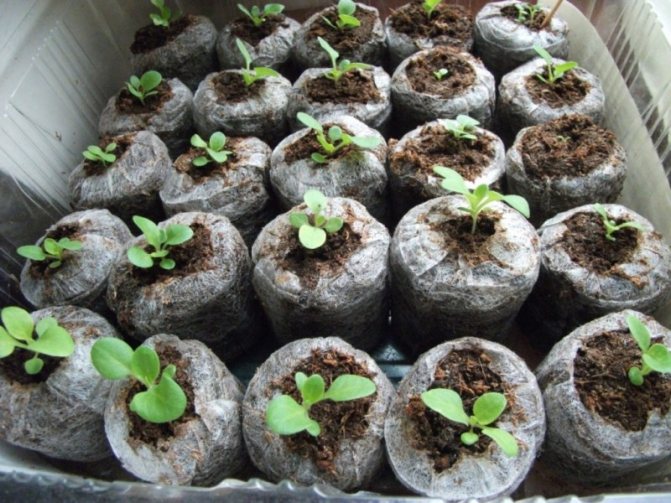

Peat molds, covered with a net, perfectly retain their shape, do not spill out, and well protect the roots from possible damage during transportation.
The selection of the scale of peat tablets mainly directly depends on the extent to which the plant grows large, and specifically its root system, until the time of the dive into the permanent soil. In addition, a huge part of urban gardeners is very limited by the amount of “vegetable garden” in their apartment. The maximum for seedlings will be provided only for a couple of window sills.
Peat tablets of different sizes will make it possible to use all the empty space in the most successful way. The ease and comfort of moving an individual sprout without the slightest risk of root destruction makes it possible to create equally comfortable conditions for any sprout.
Transplanting seedlings into the ground
Probably not the most difficult moment in plant growing is considered to be the picking of seedlings into the ground. As a rule, it is difficult to work with delicate and fragile plantings, starting with transplanting and ending with dripping in a stable place, be it a flowerpot or open ground in a summer cottage. Every time there is a real threat of damage to the root system.
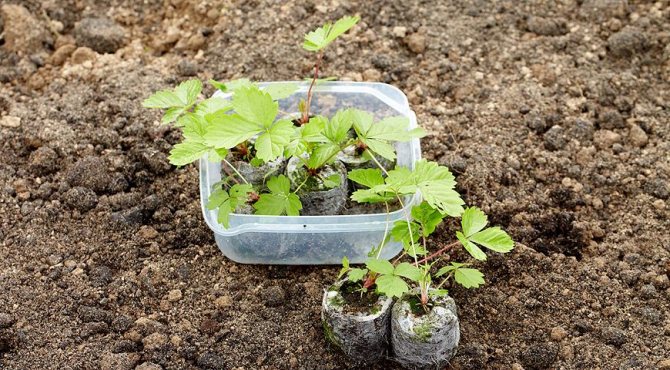

While physical defects can be avoided, it is not clear how a culture will react to a sudden change in the external environment. A sprout exhausted by travel is especially vulnerable to diseases and various infections. Almost any, even invisible to the eyes, abrasion on the roots has the opportunity to become a source of fungal disease. Perhaps one of the most key positive qualities of using peat tablets is considered to be safe planting in the ground.The root system of the plantation seems to be covered with a soft and tight protective cover, which constantly covers the delicate shoots from shocks and changes.
With the correct selection of the scale of the tablet, a clear sign of readiness for a pick will be thin lashes of roots, which begin to penetrate the side walls of the peat tablet. After that, you should not delay with a pick: the emerging plantations have the opportunity to intertwine with each other, and crushing will become problematic.
The sapling is transferred to another place and planted in the ground as a whole, together with a peat lump. The tablet is covered with a grid, entirely made from biodegradable substances. Once in natural soil, flavored with useful additives, peat protects and enables the seedlings to adapt to the new environment, and then completely dissolves.
Despite the fact that the mesh that wraps around the peat tablet does not interfere with the growth and formation of roots in any way, professional gardeners, just in case, remove it right before planting.
How to choose the right pills
You can buy the material at almost any gardening store. Experienced housewives do not recommend touching the product before buying, carefully examining it, because your harvest will depend on this in the future.
Particular attention should be paid to the structure of the pressed peat, which should not be too coarse and tough. You should also take into account the acidity index of the material, which should be indicated on the package. The majority of cultivated plants prefer a neutral acidity level.
As for the diameter, it all depends on the type of plant. So, for example, nightshades (tomatoes, peppers.) Require the largest tablet - 90 mm in diameter.
Giffy washers have proven themselves excellent. This is a brand that optimally combines high quality and affordable cost.
And finally, a little advice, if you are a novice gardener, and you plan to use peat disks for the first time, do it in parallel with the usual way of germinating plantings. This will give you the opportunity to compare methods and evaluate the advantages and disadvantages of each. You will see in practice that seedling washers are convenient and easy to use, make it possible to grow a strong and healthy plant without damaging the root system when transplanting into the ground.
Purchase and selection of peat tablets
You can order peat tablets through numerous horticultural sites, or purchase them at your nearest flower and plant store. Due to the popularity of this product, the search will not take long. At the same time, the opportunity to touch and examine the products up close plays an important role. Attention should be paid to the structure of the peat, it should not be excessively coarse. The acidity of peat can also be different. It is important to remember that acidity close to neutral is favorable for most plants. The size of the tablets depends entirely on the size of the seeds. For example, tomatoes, peppers and eggplants require tablets with a diameter of 90 mm.
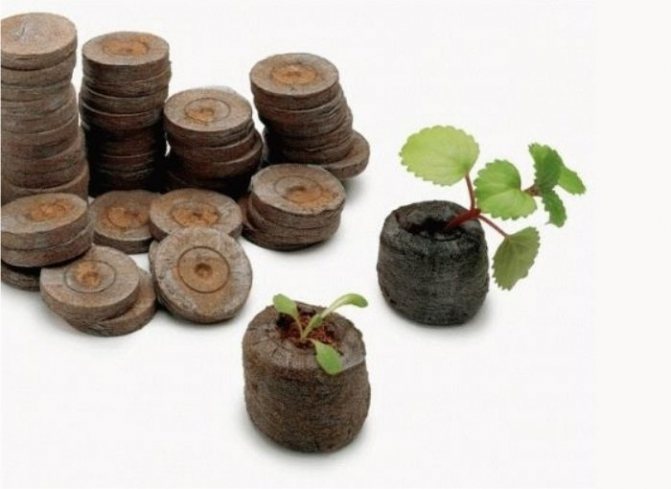

Correctly selected pressed peat tablets will allow you to get strong seedlings in a short time.
Introduction
Before the advent of special means in growing seedlings, many gardeners faced problems, since it was necessary not only to prepare the soil for planting, but also to take care of the container for the plants. Both large boxes and individual pots were used as containers.
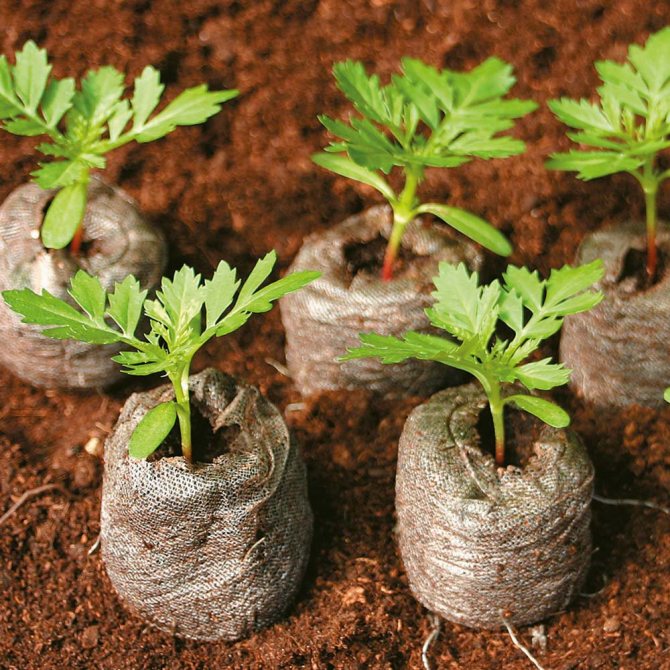

Peat tablets with seedlings
In addition, few people seriously thought about using any specialized means for growing, using almost any container as a container - from juice boxes to cups of dairy products.Naturally, the characteristics of such seedling devices were not very high.
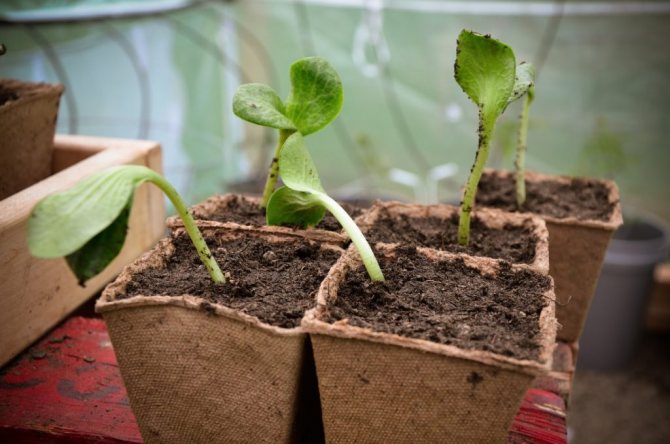

Seedlings in peat pots
A compromise solution was the use of peat pots, however, they had a number of disadvantages inherent in conventional containers. In particular, the dense material from which they were made did not dissolve well in the ground, and often, transplantation into open ground was carried out without a peat pot, since an earthen ball was removed from it, as if an ordinary container was used.
In addition, the peat pot did not provide any nutritional benefit. Practically immune to decomposition from water, it could not transfer the nutrients it contained to seedlings.
Peat tablets are the next stage in the evolution of peat pots. They are containers with a flattened cylindrical shape. The composition of such "washers" includes peat and various additional substances. These substances can be stored for a long time in a pressed form without losing their properties.
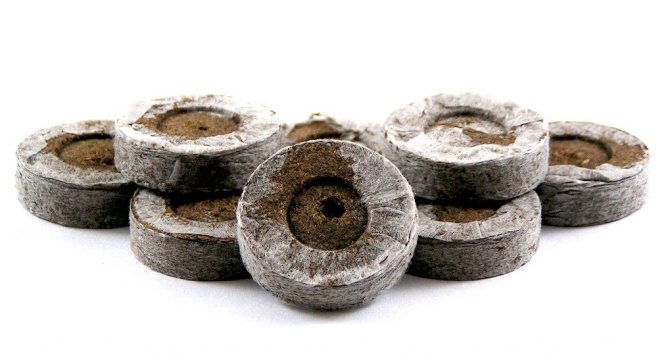

Peat tablets
Before using as a planting place for seedlings, a peat tablet is poured with warm water, swells and becomes loose. After that, you can plant seeds in it.
back to menu ↑
See also: Growing seedlings at home: tomatoes, cucumbers, peppers, eggplants, cabbage, strawberries and even petunias. All the subtleties of this issue
What are the benefits of peat tablets
Why are they so loved and recommended by many gardeners? First of all, I would like to note one general positive point - this miracle thing can simplify the growing process for the gardener.
If we consider the positive aspects in more detail, then we can understand that the benefits of using peat tablets are very tempting:
- They already contain useful, nutritious elements.... For example, they include trace elements, minerals, growth stimulants, antibacterial substances, humus. The elements and substances contained in the composition are a good start for seedlings and therefore seedlings in such a container can do without additional fertilizing.
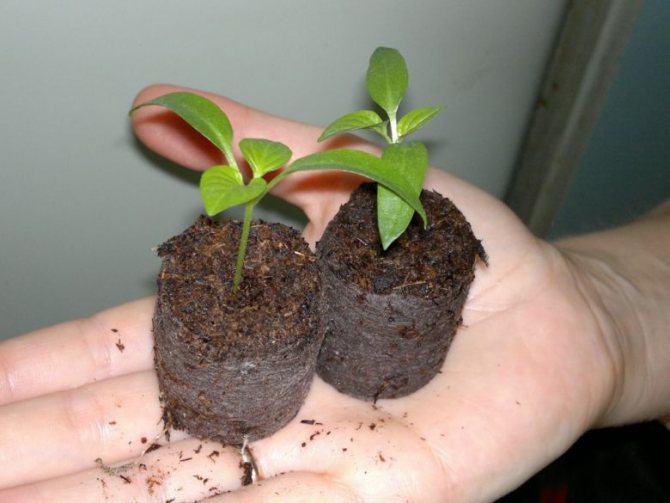

- Optimal acidity... The seedlings grow well in peat washers due to the comfortable and suitable acidity level.
- Non-woven pouch helps maintain shape... The product tends to swell and increase in volume, thanks to the pouch that does not break, the tablet maintains the desired shape.
- They have excellent moisture and air permeability... The material is able to maintain an optimal level of moisture, but at the same time waterlogging and decay is excluded due to its excellent breathable properties.
- Reduced risk of disease... Also, due to the above properties and composition, it is unlikely that the seedlings will develop unpleasant diseases of a fungal nature.
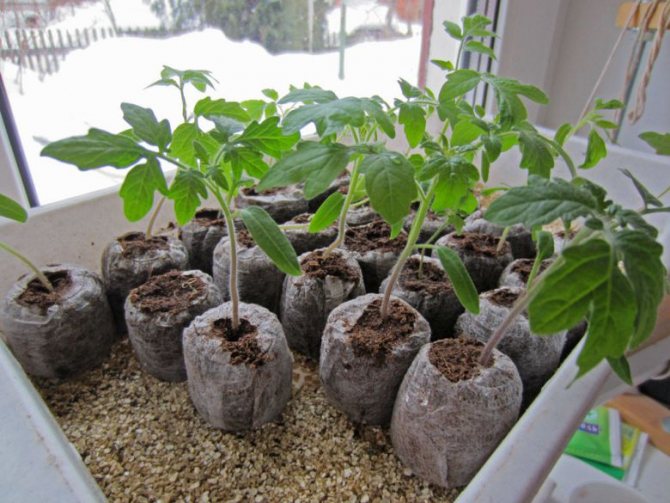

- Products do not have a specific shelf life... If you keep them in a dry, warm place, then they will retain their useful qualities for a long time.
- Convenience when transplanting into open ground. If you transplant the plant directly in a peat washer to the garden bed, then thanks to the non-woven material, the earthen lump at the rhizome will preserve its integrity and it will be more convenient for you to deal with it.
By the way! Many gardeners have noticed that if seedlings are transplanted into open ground along with a tablet, then the survival of young plants is faster and better.
In general, I would like to summarize, thanks to all the listed features, it is very convenient to germinate plant seeds in the products, the seedlings are perfectly formed, the roots of the Senets develop. And due to the fact that the seeds will be immersed in a favorable environment, the number of sprouted seedlings will be increased.And since many gardeners buy seed material in excess, fearing that not all seeds will germinate, the gardener will be able to economically purchase fewer seeds.
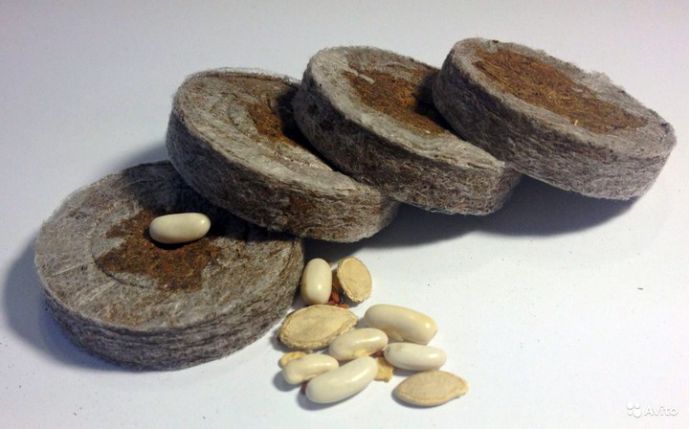

Preparing for planting seeds
How to prepare a peat base for planting? To do this, you just need to purchase a plastic pallet or a mini greenhouse with a special lid, where the cylinders are installed. The sump should be regularly filled with water to maintain the moisture level in the peat.
How much liquid is poured into the tray? It should feed the peat with moisture, but not completely soften it. Therefore, water is added in portions to control the level of absorption of the tablets.
Important! The peat tablets should not be allowed to deform due to too much water in the pan.
Of course, you will have to devote at least 30 minutes to the initial hydration of the tablets, however, you will only spend this time once. You must bring the dry tablet to a wet and slightly enlarged cup. Excess water must be drained off immediately.
How to do it? Place the tablets in a deep tray and pour warm water, leave them to swell for about 20 minutes. The tablets will quickly grow in height but not in width. After swelling, drain the excess liquid through the holes in the pan.
Transplanting seedlings into the ground
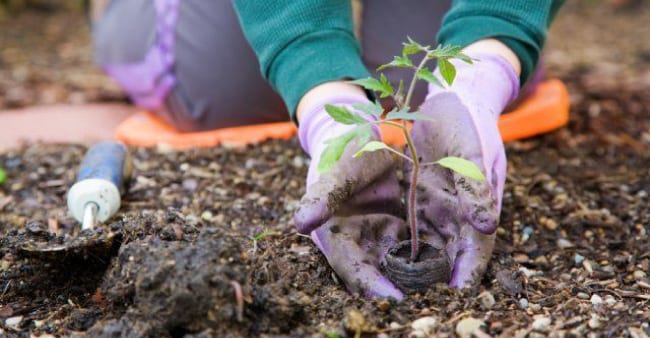

Transplanting seedlings grown from peat tablets
If 2-3 leaves appear on the seedlings, roots break through the mesh of peat tablets, urgently transplant the plants into a greenhouse or open ground. When planting seedlings, it is not necessary to cut and remove the net. It does not interfere with the free growth of roots, the penetration of moisture and nutrition. Plant transplant procedure:
- Dig holes large enough to accommodate peat tablets.
- Soak the ground well.
- Carefully place the washers in the holes, sprinkle with soil. Do not bury the seedlings. This does not apply to tomatoes that can be planted under cotyledon leaves. Place extended stems under the ground obliquely, at an angle.
- Press the soil around the plants, water it a little, and mulch with dry humus.
About cassette growing of seedlings
Often, gardeners and gardeners in our country use the old-fashioned method of growing their seedlings.
- In the fall, they harvest the soil mixture.
- Closer to spring, the prepared soil is disinfected.
- They buy seeds and plant them.
What's the output? Unfortunately, some of the seedlings do not survive to be transferred to a permanent place. Some die from a lack of light, others die due to underfilling, overflow. Another part of young seedlings will not survive and will die when diving. Gardeners and gardeners are well aware of this, so they buy more planting material so that losses do not affect harvest plans.
Is there an alternative? Yes, absolutely. This is a cassette method for growing seedlings. Growing technology in cassettes is becoming more and more popular all over the world. However, to this day, it is not particularly common in Russian latitudes.
- The cassette technology for growing seedlings appeared more than 20 years ago. A little later, with the development and modernization of the method, a whole system for the manufacture of mini-greenhouses appeared. The technologies of agricultural technology have become more perfect: sowing, watering, forcing.
- Sometimes cassette technology is compared to the method of growing seedlings in plastic cups. Yes, there is something similar, but this is only an external resemblance. Yes, sprouts in glasses also grow separately, but how much space will it take!
- When grown using a cassette method, space is consumed much more economically. If you sow seeds in plastic cups, then you will need 3-4 times more space than if you sow seeds in cassette greenhouses.
Application
Let's consider how it is necessary to grow seedlings using peat "houses":
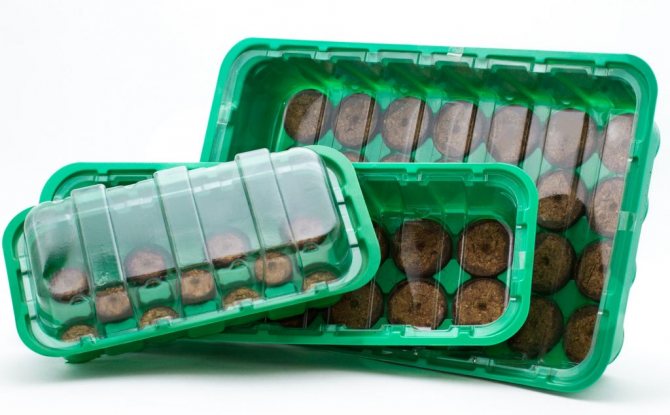

Almost always, when growing, seedlings require conditions of high humidity and temperature, therefore, together with peat tablets, it is necessary to use a mini-greenhouse
back to menu ↑
See also: How to plaster walls with your own hands: instructions for beginners + Reviews
Greenhouse preliminary preparation
Typically, the tablets are placed in the greenhouse with the seed side (the one with the indentation) facing up. If there is no special container, as a mini-greenhouse, you can use any nearby similar structure, for example, a plastic cake box... The main requirement for it is height, since it is necessary to take into account that peat tablets swell several times over; well, one should not forget that seedlings will still be located on them.
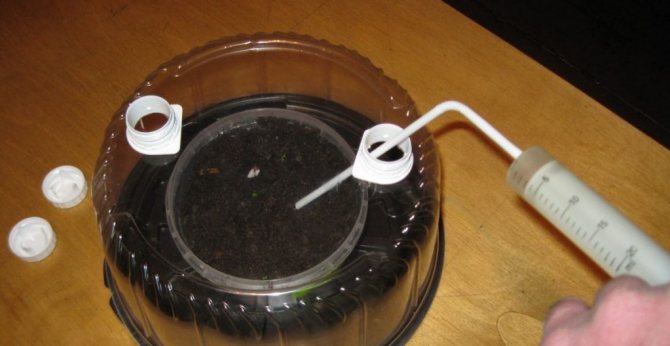

Homemade mini greenhouse from a packaging box for a cake with the possibility of ventilation and watering
An individual arrangement of tablets is also possible, that is, each in its own container. In this case, it is necessary to ensure that each of the containers has a lid. As a last resort, you can use several layers of plastic wrap as a cover.
Place tablets in a mini-greenhouse in such a way that there is no free space... This will not allow swollen lumps of peat to move over the surface of the mini-greenhouse or even fall on its side, injuring the seedlings in case of accidental shocks and shifts of the entire structure.
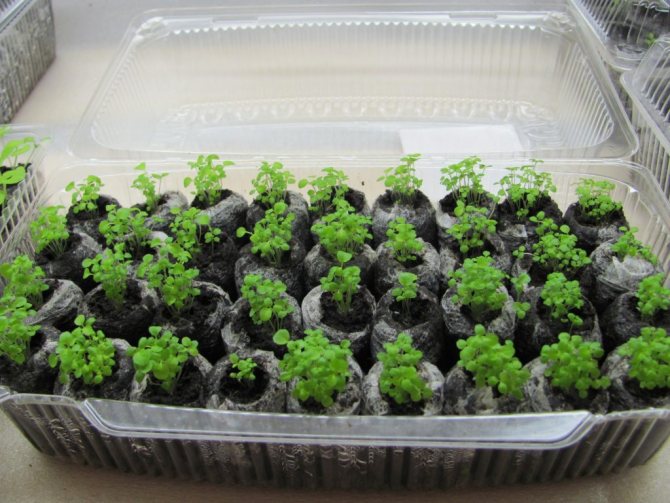

Using a plastic food container
In some cases, when the degree of filling the capacity of the greenhouse with tablets is insufficient, it is recommended to fill the space between them with some kind of filler, for example, sand or perlite.... It is advisable to disinfect the sand at the same time.
With this method of germination, certain difficulties arise in controlling the moisture level at the bottom of the greenhouse, however, in this case, the integrity of the seedlings is much more important.
back to menu ↑
See also: Pansies: 10 species, a description of the process of growing from seeds in the open field and seedlings at home, the use of flowers (60+ Photos & Videos) + Reviews
"Launching" tablets
After that, the tablets are poured with warm, preferably pre-separated water. Sometimes you can additionally add potassium permanganate to the water at the tip of a knife - this will disinfect both the soil and the mini-greenhouse.
If you are not sure about the availability of additional fertilizers, drugs and stimulants in the tablets, add them now is the time.... It is possible, after the tablets are filled with water and began to swell, add additional components to each of them. It can be fungicides, fertilizers, antiseptics, a mixture of "Baikal" and so on.
It is best to pour water not directly into the tablets, but past them, to the bottom of the container. Moreover, you should not fill in all the water at once - the tablets are lighter than water and, without having time to absorb it, they can float. At the same time, they can move, turn over, swell unevenly, and so on. In general, in this case, the structure of the greenhouse will be violated. Therefore, several toppings of water should be carried out as the tablets swell.
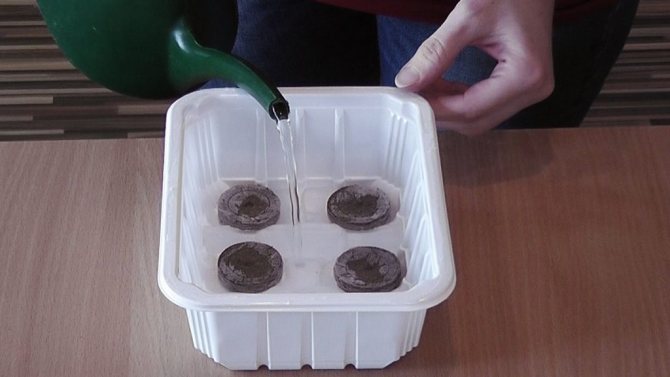

Pouring water over the pallet
In addition, it must be borne in mind that the lower the temperature of the liquid, the longer the tablets will swell. The average time for tablets to reach the "working" height of 6-8 cm is about 5 minutes at a water temperature of about + 25 ° C. And after about 15-20 minutes, the peat will be evenly saturated with liquid and it will be possible to start planting seeds.
If there is a little liquid left at the bottom of the greenhouse (about 1-3 mm), do not worry too much, it will be completely absorbed into the substrate within the next hours... If there is more water, it is recommended to remove its remnants. In this case, of course, you should not tilt or turn over the mini-greenhouse entirely. The remaining liquid is removed with a napkin or sponge.
Seedlings can be planted in swollen tablets immediately, and you can postpone the planting date at any time convenient for you - even the swollen tablets will not deteriorate. The main thing is not to forget to moisten them again before planting the seeds.
back to menu ↑
See also: The best bacteria for septic tanks and cesspools: TOP-10 effective products to improve the operation of sewage systems + Reviews
Sowing seeds
It is necessary to plant seeds in well-moistened peat tablets.... It is best to immerse all seeds in peat to a depth of 1.5 to 2 times the size of the seed itself. Seeds that are recommended to be germinated on the surface can be left on top, or you can sprinkle them with a layer of minimum thickness. As a last resort, which seeds are simply pressed into the peat.
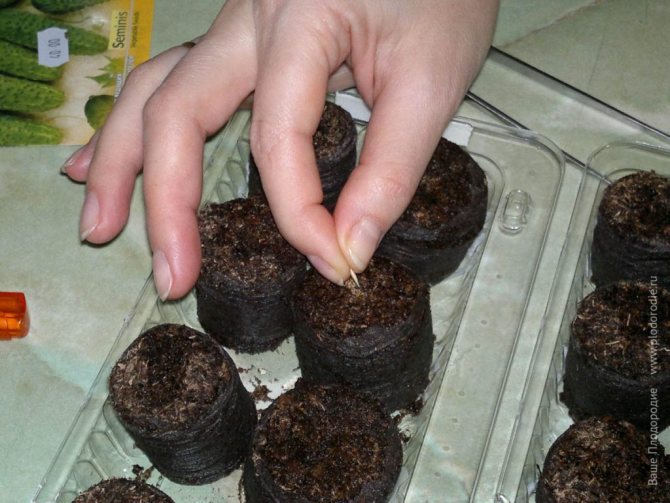

Seed sowing process
It is recommended to sow small seeds with a small stick such as a toothpick... The seeds are pre-poured onto paper of a contrasting color, with which they will be placed in peat tablets using a wet stick. Depending on how far the stick is immersed in the seeds, you can adjust their number when planting. If the seeds are large enough, you can safely plant them with your fingers.
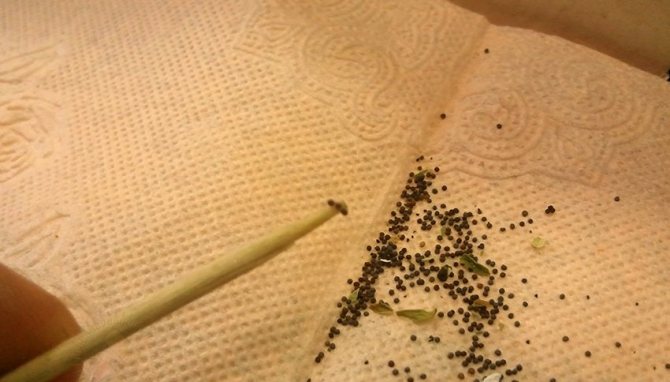

Sowing seeds with a toothpick
After all the seeds are set in swollen tablets and covered with a layer of soil, the greenhouse is closed with a lid and transferred to a warm place.... The greenhouse should be provided with ventilation suitable for the type of seedlings grown.
back to menu ↑
See also: Eschsholzia - a poppy plant from the Wild West: description, types, growing from seeds, planting in open ground, care (80 + Photos & Videos) + Reviews
Growing seedlings
Consider the most important rules for growing seedlings in the case of using peat tablets. If it is necessary to place the seedlings under sunlight, for example, on a windowsill, then it is necessary to take measures to protect the seedlings from cold air that may come from the window. To do this, place the box with pills on a layer of heat-insulating material.
If necessary, to ensure longer daylight hours, the mini-greenhouse can be installed under fluorescent lamps.
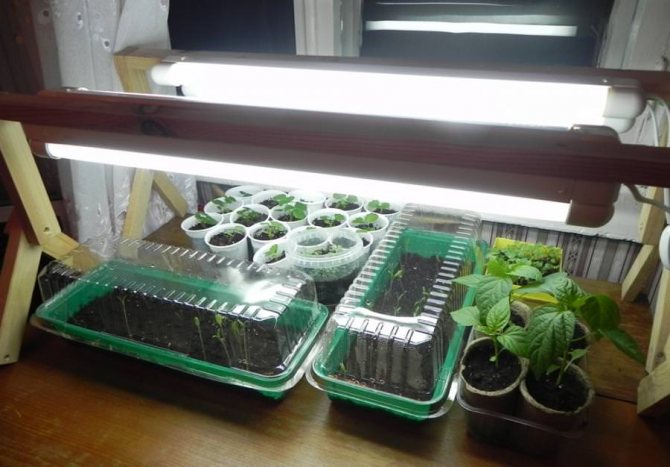

Using additional artificial lighting
Airing should be carried out regularly, as a rule, it is almost always combined with soil moistening. Maintaining a constant moisture content of peat pellets is the key to success in growing seedlings in this way. It is the errors associated with wetting the substrate in tablets that account for 99% of the failures when using this method. Even a short-term drying out of the soil can have irreversible consequences and become detrimental to seedlings.
Before the seeds germinate, watering must be carried out in a drip method, moistening each tablet individually. An alternative is to use a spray gun that is configured to atomize a suspension of water with a minimum particle size. In addition, the pressure of the jet should be minimal to prevent washing out or even weathering of small seeds from the soil.
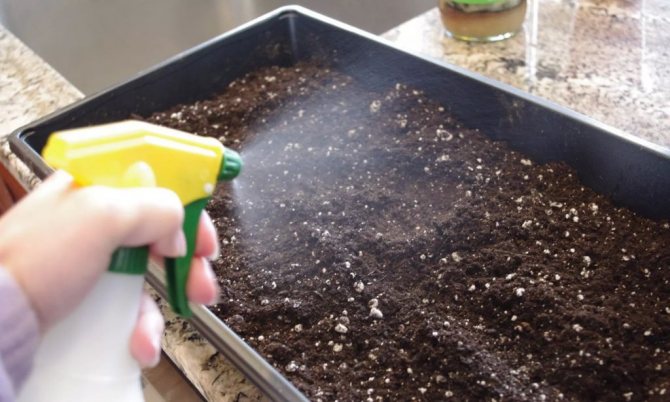

Watering with a spray bottle
Watering already sprouted plants is done by pouring liquid directly into the pan, or onto the bottom of the mini-greenhouse. Peat absorbs this liquid well enough, evenly filling the tablets along the entire height. Such properties of peat are due to its good capillary structure.
In addition, the amount of liquid contained in peat is sufficient to nourish the plant, however, waterlogging does not occur, which can cause the appearance of root rot. This is the second important advantage of peat tablets after their convenience - the concentration of liquid in the substrate will never exceed the critical value that is dangerous for plants.
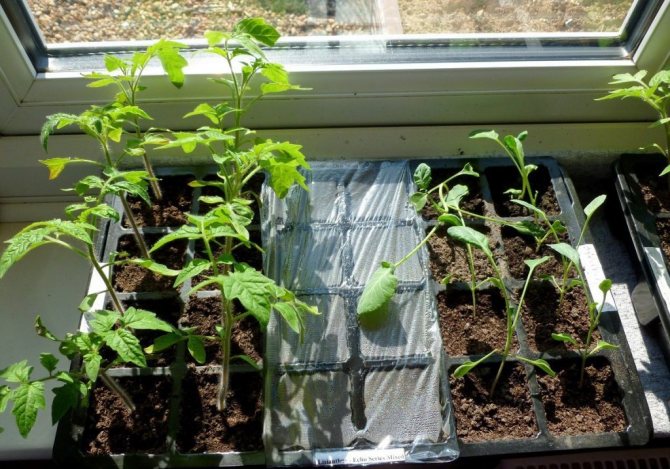

Seedlings on the windowsill
Do not place a box with seedlings near heating devices.They will not be able to achieve complete tightness (and this is not necessary in most cases), but dry air near the heaters is able to evaporate moisture from the peat substrate much more quickly.
When in the future it becomes necessary to transplant plants into a greenhouse of a larger volume, or to transfer them somewhere, there are no special problems with this - the seedlings are easily transferred by hand, and the peat tablet is not destroyed at the same time.
As the seedlings grow, it is much more important than watering to monitor the seedling root system so that it does not go beyond the tablet. If you miss this moment and transplant the plants into open ground or some kind of intermediate container with the roots sticking out, they can be easily damaged and the whole point of peat tablets when growing seedlings will be lost.
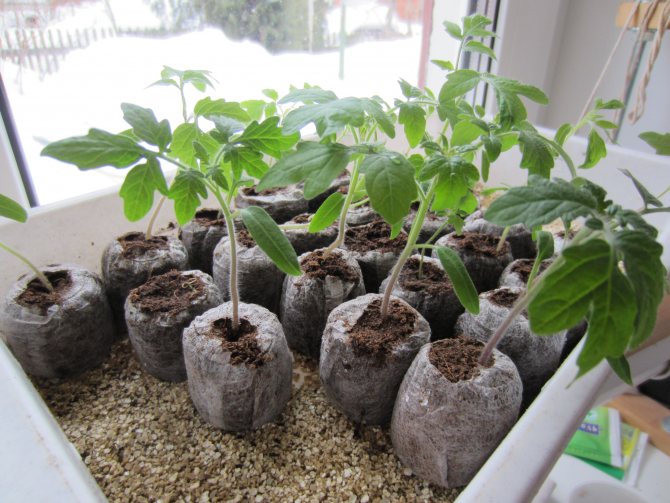

Adult seedlings before planting in the ground
To keep the root system intact, it is necessary to regularly inspect the tablets for root punching out.... Already at the first such cases, plants with similar problems should be transplanted into individual containers. Each case is individual, so the decision on the timing of disembarkation should be made taking into account various factors. Perhaps, if there is already a little time left before planting in open ground, you can wait with a transplant, but simply follow more closely the specimens with sprouted roots.
See also: Phlox - record holders for flowering: description, planting in the open field, reproduction and care (85+ Photos & Videos) + Reviews
What other pills are for seedlings
In addition to peat tablets for growing tomatoes, cucumbers and other crops, you can use pressed washers from other raw materials.
Uses of coconut pills ↑
If you plan to grow plants not in a common box, but separately, coconut seedling tablets are optimal for you. They consist of coconut - 70% peat, 30% shavings. For crops that need a lot of oxygen to grow, this material is best suited. Coconut flakes for seedlings serve as a nutritious component. The plus is that bacteria do not multiply in it and pests do not live in it.
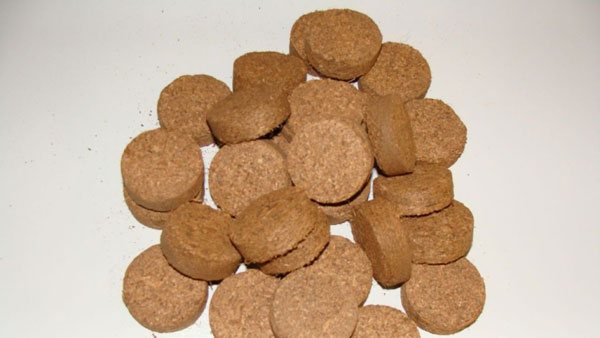

This is what coconut seed cylinders look like.
To prepare round dice for planting seeds, you need about 40 ml of warm water. You can pour the liquid directly onto the tablet. It will grow in size and taller, just like its peat counterpart. The difference is that after getting wet, the coconut flakes turn dark brown. It has good antibacterial and heat-conducting properties, as well as the ability to keep all the nutrients absorbed with water inside the fibers.
How to choose pills
What they pay attention to when choosing:
- The quality and structure of the peat substrate. It should be free of extraneous inclusions, various coarse fibrous structures. Their presence indicates that the product is of poor quality. In addition, coarse-fiber tablets will not breathe well. There is a high probability of stagnation of water, damage to seedlings with gray rot, black leg and other diseases.
- Diameter. For growing seedlings of large, fast-growing crops, it is worth choosing a larger diameter washer. For small ones - on the contrary, small ones. This is important because the wrong choice leads to problems and complications. For example, if a small tablet is chosen, and the sprout is large, a situation may arise when the plant is not yet ready for transshipment, but has already outgrown its landing site. For small seeds, washers with a diameter of 2-3 are suitable, for large ones - 7-9 cm. The most popular cylinders are 4-5 cm. Suitable for most garden and indoor crops.
- The acidity or pH of the soil. The parameter must be indicated on the manufacturer's packaging. It is selected taking into account the requirements for the cultivation of a particular crop. For example, for conifers, the optimum pH is 4.5.For rhododendrons, hydrangeas, azaleas and a number of others - 5.5-6.3. Most garden and home crops are satisfied with an acidity of about 5.3-5.7. In such a pH, seeds of green and spicy crops, vegetables, flowers and others germinate quickly.
- The presence of a grid. Better to buy circles with a grid. It holds the mixture after swelling. In addition, it is impregnated with antibacterial, antiviral agents and fungicides. Will be an additional protection against diseases, pathogenic microflora. Analogues without a grid, after getting wet, turn into dust, blur and lose their shape. This is tolerable if the tablet is placed in a pot of soil. But it is very inconvenient when the seedlings are grown in containers.
How to choose
When choosing cylinders with pressed peat for growing seedlings, it is worth taking into account their characteristics. For each type of seedling, tablets of a certain type are suitable:
- The diameter of peat pellets can vary from 27 to 70 mm. For vegetable seedlings, 41-42 mm washers are used, and small ones are suitable for germinating flower plants (petunias).
- The presence of a shell that should partially cover the bottom of the cylinder. The bad material will immediately get wet and the peat will lose its shape. In this case, the shell can be reticulated or cellulose, there is no big difference in the material for plants.
- The structure of the peat fraction is porous, dark red, brown in color. It is good if the manufacturer, using mineral additives, has created a product with optimal acidity.
- It is better to buy products from well-known companies (Jiffy, Ellepress) - they try to keep the brand and offer quality products.
- Together with the substrate, you can purchase a special container - a pallet with cells or with a ribbed bottom, which will prevent peat from rotting.
Ellepress tablets
The Danish peat tablet Ellepress is a cylindrical container for planting seeds and cuttings of plants. Peat containers have become very popular in Russia due to their ease of use at home and on an industrial scale.
How do Ellepress containers differ from other peat seedling tablets? The shell of the container is not a mesh cover, but a paper base. However, this paper differs from conventional writing paper - it is a biodegradable product developed using nanotechnology. The paper cover allows the roots to breathe freely and grow through as the root system develops.
Also worth noting is the quality of the peat filling the containers. It is a white peat from Canada and Finland. Its distinctive feature is its high hygroscopicity and long-term moisture retention - it does not dry out as quickly as regular brown. This makes it easier to care for the seedlings, as it does not require frequent watering.
Note! The seeds do not need to be soaked before planting - they are immediately immersed in the ground.
The shape of the container is ideal for rearing young animals, as it does not require the installation of an additional container such as a pallet. The paper firmly holds the substrate inside, eliminates deformation of the shape. White peat does not dry out for a long time, which makes it even easier to use Ellepress products when caring for young growth.
How to prepare containers for work? Using the same technology - we immerse them in warm water and wait for them to swell. Then we take the containers out of the water and plant the seeds - one at a time.
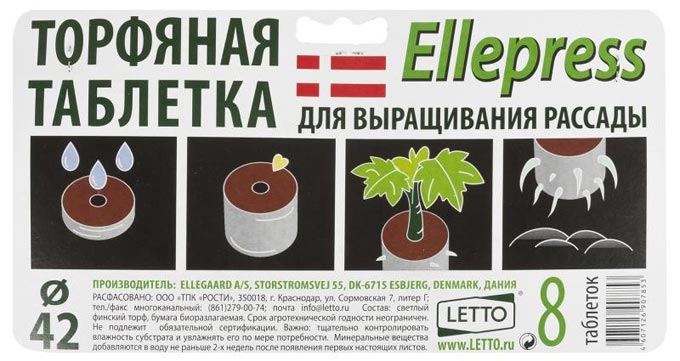

Selection Tips
Commercially available tablets vary in size and substrate characteristics. The diameter of peat tablets from 20 to 90 mm provides for:
- sowing small seeds - 20-36 mm;
- sowing medium-sized seeds - 40-50mm;
- sowing large seeds - from 60 mm and more.
In addition to peat, tablets usually include:
- humus, which creates a nutrient medium;
- antibacterial additives that prevent the development of diseases;
- minerals.
The tablets have different acidity - from 5.2 to 6.4, i.e.you can choose the optimal environment for each type of plant.
On a note! The instructions on the composition of the peat briquettes and the pH value are given on the packaging. Often they are sold in bulk, but if the seller is not able to accurately tell about their parameters, it is better to make a purchase at another outlet.
Seed care
During the growth of seedlings, it is necessary to constantly monitor the moisture content of the peat, adding water to the pan. After watering, the excess water is immediately drained, but not before the peat absorbs the required amount of moisture.
Seedlings must be aired daily by opening the films and covers for 30 minutes. As soon as the first shoots appear, airing is done more often. It is necessary to ventilate, because the ingress of condensation on young leaves can damage them.
Do I need to add additional fertilizing during the development of seedlings? The peat substance provides the seedlings with everything they need; subsequently, gardeners add a fertilizer diluted in water, which is poured into a tray. Top dressing should correspond to the needs of the seedlings. When should you add top dressing? Sprouted 2-3 weeks after germination. In some cases, top dressing is sprayed onto plant leaves from a spray bottle.
After the seedlings have been strengthened, the peat cups can be placed in individual pots. Some seedlings need hardening, for this they are taken out to a loggia or covered balcony for a certain time.
When is the plant ready to be transplanted into a garden bed or individual flower pot? As soon as the roots appear on the side of the peat tablet, the plant can be transplanted.
How to plant plants in the garden? To do this, they are placed in the ground along with a glass. The mesh on the walls will completely dissolve in the ground; it does not need to be removed first. The mesh allows the roots to germinate freely, does not restrain their growth. The plant is rooted in the soil and covered with soil, having compacted it a little.
Rooting cuttings
Peat pots are also good for rooting cuttings. They can grow flowers from leaves, such as violets. To do this, prepare a peat cup, form a wide depression in the center and place a leaf or a stalk. When watering, water should not fall on the cutting - pour it into a sump or plastic container.
3-4 weeks after planting the cutting, the peat container is transplanted with it into an individual flower pot.
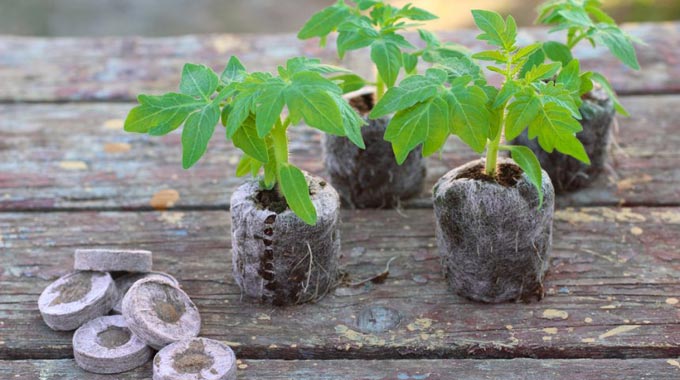

How to transplant plants from tablets into soil
When you notice that the roots have begun to appear from the cylinder, it means that they already require a transplant. This must be carefully monitored, since if you notice it too late, then by that time the roots may already be strongly intertwined. To prevent this, place the containers slightly at a distance from each other. When replanting, cut the mesh to provide space for the roots. When you move the plant into the ground, you do not need to remove it from the tablet. If the shell of the tablet is made of a thin layer of cardboard, then do not cut it - the roots will be able to break through on their own.
Varieties
Peat tablets can be classified according to the composition of their ingredients, as well as their size.
Peat tablets may contain the following substances:
- growth promoters
- immunity stimulants
- rooters
- means for combating fungal and bacterial infections
- etc
Their diameter can range from 24 to 90 mm, and the pressed thickness can be from 8 to 30 mm. It should be understood that the smaller the tablet diameter, the less nutrients it contains.
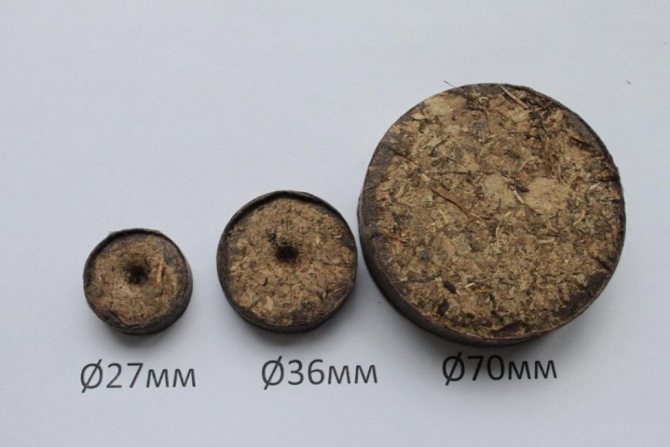

Various tablet sizes
For example, for growing plants, such as tomatoes, which are planted in the ground already in adult form, the use of small-diameter tablets is not enough. For such plants, tablets with a diameter of at least 40 mm are used. While for seedlings of many annual flowers, tablets of the minimum diameter are used.In general, the choice of a tablet for a particular plant depends not only on its type, but also on the planned growth time.
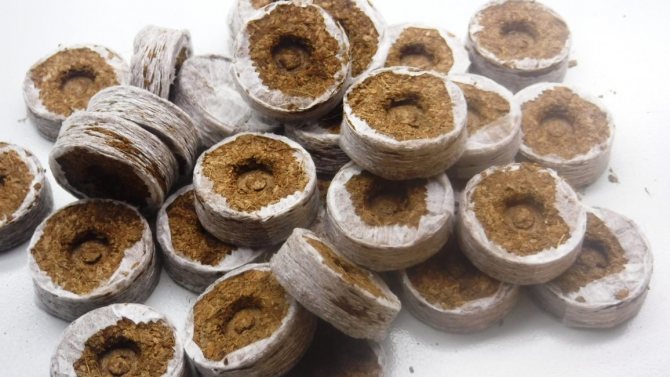

Coconut analogues of peat "circles"
It is preferable to use tablets in the production of which a mesh was used. She is not only able to hold the mixture after it reacts with water, but often it is she who is a barrier to negative invasions - the mesh is impregnated with fungicides or antiviral and antibacterial drugs.
We suggest that you familiarize yourself with: Korean chimcha recipe for Chinese cabbage?
In addition to universal tablets, there are also highly specialized products created for various plants. They can differ, for example, by different degrees of peat hardness, different dressings, and so on.
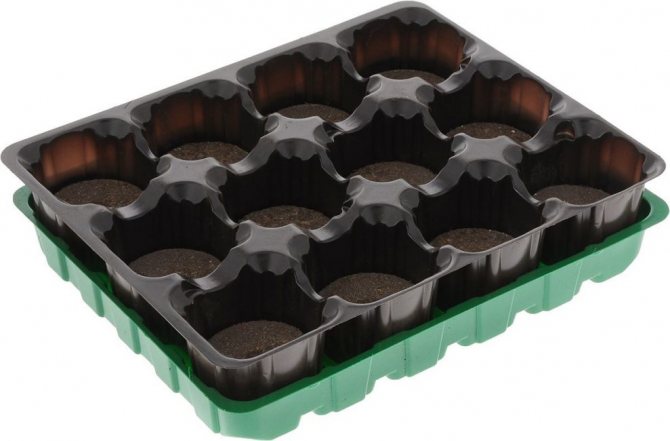

The simplest box for growing seedlings in peat containers for 12 places
However, it would be a misconception to believe that the tablets are sold exclusively by themselves, without any specialized seedlings with their help.
There are a number of special devices designed to organize the cultivation of seedlings using peat tablets. The most popular at present are specialized boxes for seedlings and mini-greenhouses for "tablet" cultivation.
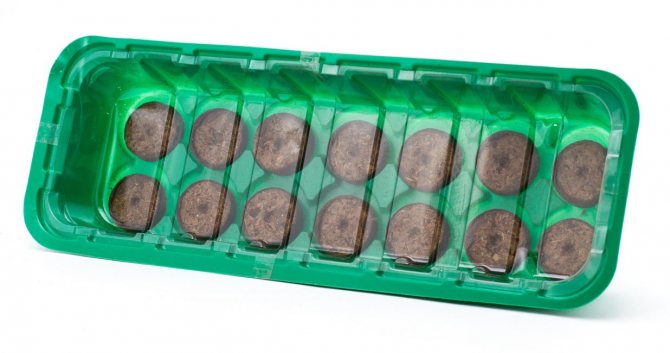

Mini greenhouse for seedlings grown using tablets
The use of such means greatly simplifies the work of the gardener and gives him the opportunity to get rid of the mass of routine work associated with growing seedlings. The adaptations can be more complex. Most often, they include special transparent covers that can be closed both hermetically and using special ventilation holes.
Mini greenhouses for tablet sowing
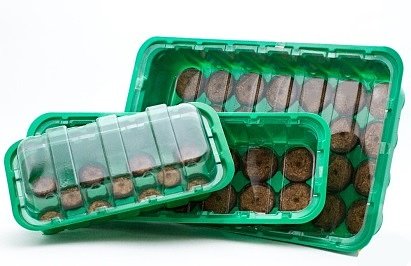

- Mini-greenhouses are specialized containers designed for growing seedlings, rooting cuttings. Outwardly they resemble an egg tray.
- There are special recesses or recesses for peat or coconut cylinders.
- To prepare the bed for sowing, it is enough to pour water into the pan, wait until the pressed cylinders swell.
- Then cover the container with a lid and place in a warm place.
Mini-greenhouses are designed in such a way as to provide a favorable microclimate, to protect sprouts from diseases and bacteria. The optimum level of humidity is maintained here, there is ventilation for continuous air circulation.
The advantages of greenhouses:
- Convenient, structurally thought out to the smallest detail. Compact, they will find a place in a large house, small apartment or utility room. Unlike bulky boxes and containers, they take up only 1 m2 of space, leaving the rest of the space free. On 1 m2 of a cassette mini-greenhouse, it is possible to grow up to 150 healthy, viable plants.
- In boxes, homemade containers, it is often not possible to adjust the seeding density. As a result, the planting is thickened, strong shoots begin to suppress, clog the weakest. When sowing in cassettes, this problem is easily solved. Each seed takes up space and emerges in one cassette cell. Due to the limited area of cells, the root system grows powerful, sinewy, while the growth of the stem, on the contrary, slows down. The sprouts are less elongated, more go to the root than upward.
- Cassettes can be used many times, do not lose their properties and characteristics over time. They are considered an ideal environment for agricultural technology of any garden and home crops. Eliminate the need to look for what and where to plant. Provide cleanliness and hygiene when working with seeds, seedlings.
The simplest options for specialized containers with a transparent lid are shown in the photo. Moreover, the cover can be airtight or with ventilation holes. There are also more complex devices.What to choose depends on the task at hand, the price of the capacity and personal preferences.
Important! When choosing the height of the container, take into account how much the tablet will grow after swelling. In the process of growing seedlings, the lid of the container should not be close, especially in contact with the surface of the swollen substrate.
Possible mistakes
Unfortunately, no one is immune to failure. How often the irreparable happens, and the seedlings begin to wither, die. Why is this happening? Let's consider the most common reasons:
- The seeds are of poor quality. Illiquid planting material is often obtained when collecting from their own garden or plantations of friends and acquaintances. Problems can be avoided by ordering seeds from the agricultural firm Gavrish, Agroelita and other well-known seed brands.
- If the seeds are elite, then they overdid the preparation. Perhaps, additional treatments with stimulants and growth activators were not needed. Probably, the stratification was not carried out according to technology or was not needed at all.
- At the stage of preparation for embedding the planting material, a substrate of poor quality or contaminated with bacteria was selected. Or the container for forcing seedlings was selected incorrectly.
- When sowing, the planting material was too deep in the ground. As a result, the seeds did not germinate well, grew weak, or did not hatch at all.
- The deadlines for forcing the culture were not met. If you are late, or vice versa, plant very early, the biorhythm of the seedlings is lost, an internal alarm clock that tells the plant when to grow, when to bloom, and when to wither.
- The reason for the death of seedlings was the thickening during sowing. As a result, the plants defeated themselves. At first, the weakest died, but then the strong shoots did not have enough strength for normal growth and development.
- The irrigation and ventilation regime was not observed. As a result, the sprouts died either from drought or from excess moisture.
Coconut or peat washers, which is better
Both agronomists and gardeners are pondering this question. There is no consensus yet.
- Peat tablets are ideal for the development of crops at an early stage, that is, after planting the seeds, in the section of biting, active growth. Light peat-peat substrate breathes well and passes water well. Peat consists of rotten plants growing in swamps. Contains enough nutrients to provide the seedlings with everything they need.
- Coconut barrels are composed of fibrous coke shells. However, it has been proven that coco-soil has increased air permeability. Due to the unique composition and characteristics of coke washers, the germination of seeds of shrubs and trees, vegetables and flowers is increased. Strong and completely hopeless and weak.
- Due to the air permeability of the cocoa soil, the roots breathe well, as a result of which nutrients reach the seedling faster. Also, a large amount of air in coconut soil significantly reduces the risk of putrefactive fungi and diseases.
- Peat pellets have lower air permeability. As a result, during overflows, the seedlings can sour, get sick and die. On the other hand, a lot depends on the grower. If you follow the watering regime, do not overflow the garden, there will be no danger of infection with rot and fungi.
Food for thought! Agronomists are unanimous in the opinion that for active growth and full-fledged development, seedlings need at least 20% air in the soil. This parameter is typical for coke soil.
What diseases and pests can lie in wait for pepper seedlings grown in peat tablets
The possible set of diseases when grown in tablets is the same as under normal conditions, only their probability is significantly lower. It can be fusarium, and gray rot, and various spots, etc. However, more or less often there is only a black leg. It can infect seedlings with too high humidity and lack of heat.Symptom: wilting of the seedling, the appearance of a black constriction at the bottom of the stem. It is better not to try to save the plants, but to carry out a new sowing. After 2–3 true leaves have emerged, the risk of a black stalk is minimal.
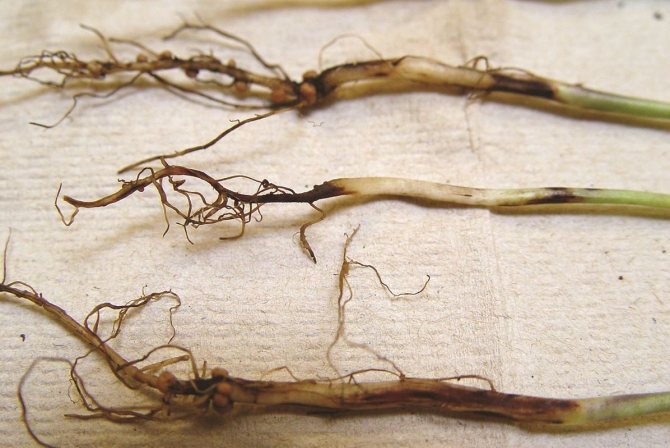

Perhaps only the black leg remains among the dangers when using pills, and even then only if the technology is violated
Among the pests - the same as in normal conditions (aphids, whiteflies, thrips, etc.), but if reliable tablets and seeds are taken, the probability of their appearance is practically zero.
Sowing seeds
How to sow seeds in pots? It is unacceptable to plant two seeds in one container, then to plant the shoots - the pots are intended for the development of one seedling. Each pot has a hole for one sprout, so you should not experiment with two or three seeds.
If the seeds are small, you must first sprinkle them on a white sheet of paper and pry them with a damp toothpick. The planted seed is covered with peat, fluffing the top layer of soil with the same toothpick. If the seed grows in the light, it is not covered with soil. If the seeds are large, plant them with your fingers.
Note! The planting depth of seeds should not exceed two times its size. You cannot bury the seed deep in the ground.
Do the seeds need to be watered after planting? It is not necessary to do this, since the peat soil is pre-saturated with moisture. After planting, cover the pots with plastic wrap, plastic lids or glass and place the tray in the desired location. As the seeds develop, add liquid to the pan and periodically ventilate the plants by opening the lid.
Where should the seedling tray be installed? This should be a bright, warm place, but not next to a radiator.
